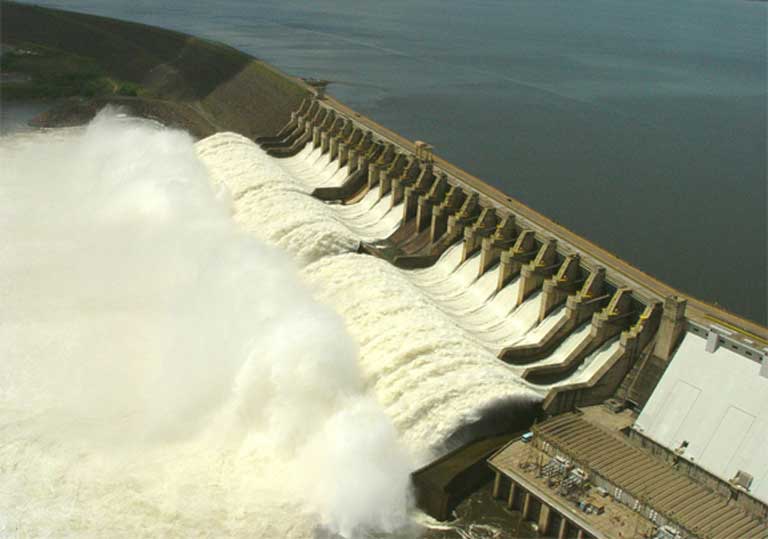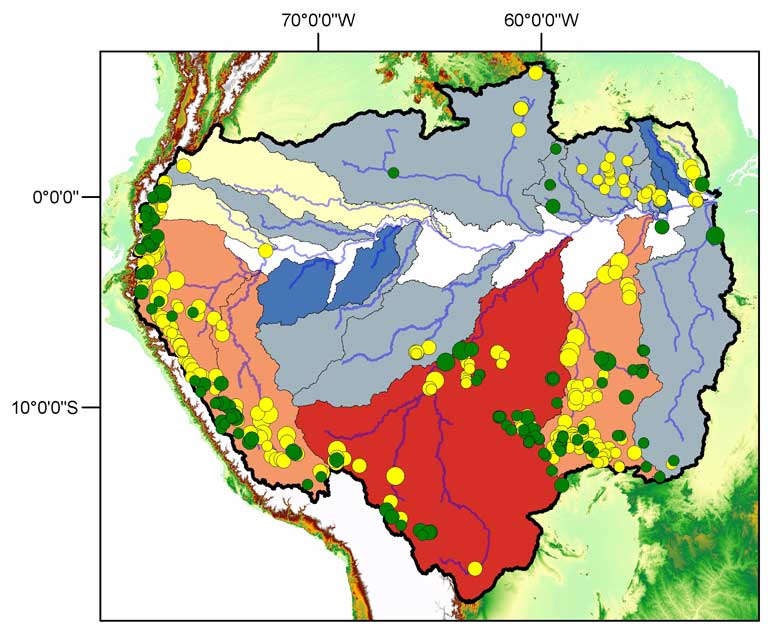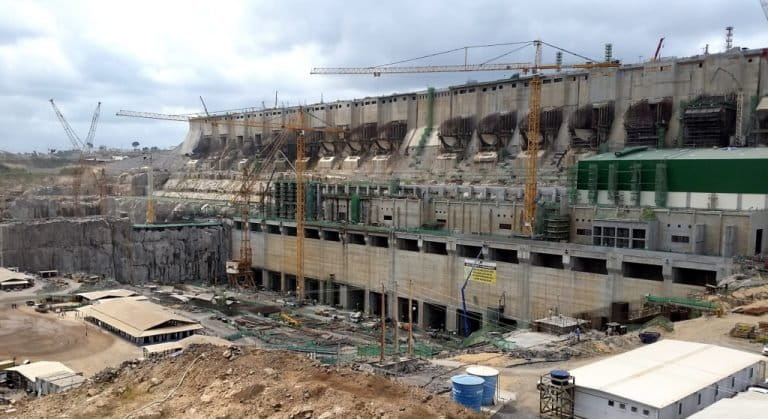

The Amazon basin faces irreversible environmental disturbance on an enormous scale due to hydroelectric dam development. Hundreds of existing and planned dams in both the Amazonian lowlands and the Andean headwaters are already impacting, and will continue affecting, waterways, floodplains and the estuary by disrupting sediment and nutrient flows.
This is the message of a new study, published in Nature, which quantified the impacts of dams on the hydrology and geography of each of the Amazon’s 19 major sub-basins.
The study, led by Edgardo Latrubesse of the University of Texas at Austin, aimed to go beyond previous work, which typically focused on local impacts of individual dams. Instead, his team developed a new metric: the Dam Environmental Vulnerability Index (DEVI) to assess the possible cumulative, basin-wide impacts that planned dams would bring.
The DEVI metric incorporates assessments of the integrity of the basin, including its vulnerability to land use change and erosion; fluvial dynamics, such as the influence of sediment fluxes and flood pulses; and the extent of the river that would be affected by dams. Taken together, these factors allowed the researchers to score each sub-basin on a scale from 0-100, with higher values indicating greater vulnerability.
In total, the study accounted for the potential impacts of 428 built and planned dams generating more than 1 megawatt; 140 of these are already under construction or operational. Four sub-basins — the Madeira, Ucayali, Marañon, and Tapajós — had DEVI scores higher than 60, indicating serious vulnerability.

(Photo courtesy of International Rivers on flickr)
Compulsory reading for policymakers
The research was welcomed as “exciting and long-awaited,” by Alexander Lees, of Manchester Metropolitan University, UK. Lees, who has studied the impacts of dams on the region’s biodiversity, but was not involved with this latest study, said it “should be compulsory reading for anyone involved in making environmental policy decisions in the Amazon region.”
Sarah Bardeen, of International Rivers, said the study “outlines the very real threats facing the region, and persuasively argues for the urgent need for basin-wide planning.”
The Madeira River received the highest DEVI score under existing conditions (77), which worsens (to 83) when projected impacts of planned dams are factored in. The Madeira basin scored highly for all three component indices, due to its sediment-rich Andean tributaries (with the highest sediment yields in the Andes-Amazon watershed), and due to the Madeira River Hydroelectric complex, encompassing the recently built Santo Antônio and Jirau mega-dams. This complex will intercept sediment from 80 percent of the Madeira watershed.
The impacts that dam development would bring to the Tapajós basin have been referred to as “a crisis in the making,” and the new study bears that out. With 90 dams planned, and 28 already in place, “the Tapajós River itself and all its major tributaries will be impounded,” the scientists write.
For the Amazon mainstem and its associated floodplains, the consequences of disruption to sediment flows will have “major impacts” on the dynamics and ecology of the region. “500 million tons of sediment per year are exchanged between the Amazon River and its floodplain,” said Latrubesse, who has studied the Amazon for more than 20 years.

Why sediment matters
“[S]ediments are a key factor,” Latrubesse explained. “[T]hey carry nutrients and feed the ecosystems, build landforms and contribute to river morphodynamics by triggering processes of erosion and deposition and the regeneration of forest,” which ultimately increases the diversity of habitats and species found in the “mosaic of the floodplains.”
Adverse impacts won’t end there: Amazon sediments discharged into the ocean play a role in marine and coastal ecosystems too, including mangrove forests and a recently discovered Atlantic Ocean coral reef. The Amazon’s freshwater plume — that Latrubesse describes as extending to an area of 1.3 million square kilometers (more than 500,000 square miles), or twice the size of Texas — also influences ocean temperature. Change in sediment discharge therefore “has the potential to trigger climatic impacts at regional and even at inter-hemispheric scale,” he said.
As physical and hydrological changes take place, the diversity of habitats that make up the Amazon ecosystem, and the species that rely upon them, will be put at risk. “[T]he current dam-building regime will likely result in myriad species extinctions in this the most biodiverse freshwater ecosystem on the planet,” said Lees.

Latrubesse emphasized the importance of recognizing connections between the physical processes shaping the river, and the ecology and diversity that the river system supports. “We found a strong correlation between DEVI and potential impacts on aquatic ecosystems,” he said.
“There is still an urgent need to quantify cumulative impacts on species… throughout the basin,” Lees added. “It seems preposterous that no such study exists, but to get to that point we need to have fully described the basin’s biodiversity,” which is still a long way off.
“We urgently need the volumes of data collected in the numerous environmental impact assessments [for individual dams] to be made public so that results can be synthesized and full catchment trade-off analyses undertaken,” to avoid as many extinctions as possible, Lees concluded.
The impacts of dams on the territories, livelihoods and rights of indigenous people and traditional communities in the Amazon basin should also not be overlooked, noted Bardeen. “Many of these rivers are indigenous rivers in indigenous lands, and this runaway development has occurred without their consent.”
Latrubesse acknowledged that social concerns were “another important issue that has to be considered,” and said the study team was “confident” that DEVI will “enrich the discussion on socio-economic aspects, particularly social conflicts in the basin.”

(Photo courtesy of the USGS Columbia Environmental Research Center)
Collective basin-wide management the way forward
With seven of the ten largest mega-dams still in the planning stages, the scientists say that immediate, collective action between all Amazon nations is needed, particularly as dams will have impacts that extend hundreds of miles downstream.
The team points to the Amazon Cooperation Treaty Organization (ACTO), which exists to promote sustainable development, as a possible “catalyst to build new international actions, policies and plans for river management.”
“We are promoting here the generation of a plan for basin management by using existing institutional and legal capabilities,” Latrubesse said.
Participative strategies, that include all sectors and involve multidisciplinary scientists, should be instituted for assessing future development, while new conservation units should be established, the researchers argue: “These conservation units could be explicitly designed to recognize and protect watersheds, main channels, floodplains and eco-hydro-geomorphological services; and to assess sites of important natural, cultural, scenic and economic value to local communities.”

(Photo © NeiI Palmer/CIAT for CIFOR on Flickr under a Creative Commons Attribution-NonCommercial-NoDerivs 2.0 Generic license)
Bardeen agrees that legislation should be improved, but in addition, “bodies like the UN should also be looking at creating a global initiative to protect rivers,” she commented.
Bardeen also strikes a note of caution. “We welcome recommendations for transboundary legal frameworks for dam development. But it’s important to remember two things: First, institutions like ACTO have traditionally been very bureaucratic, and they’ve never engaged meaningfully with affected communities, indigenous peoples, and other actors in civil society. To be effective, these institutions would need to embrace transparency, and overcome longstanding practices of ignoring the rights of local communities.”
“Second, though transboundary legal frameworks are very useful, they’ll need to go hand-in-hand with anti-corruption efforts,” she said, citing corruption as exposed by Brazil’s Lava Jato scandal, for example, as a key driving force behind dam-building.
“Corruption has also led [Brazil] to neglect its enormous potential for truly sustainable renewables, especially solar power, which would render the construction of new Amazonian dams unnecessary,” Bardeen concluded. Alternative energy implementation is also championed by Latrubesse and his co-authors.
(Photo by Pascalg622 used under a Creative Commons Attribution 3.0 Unported license)
Broader damage of dams
The study’s authors note that dam-related disruption of sediment and nutrient flows isn’t the only source of environmental and social harm. The high-risk nature of many dam projects causes them to run significantly over budget and to then suffer from reduced electrical outputs as land use and climate change alter the hydrology and reduce the river flow at dam locations. This seriously undermines the economic viability of Amazon dams.
Hydropower’s green credentials have also been overturned by studies demonstrating that dams are net contributors to greenhouse gas emissions over their lifetime. Biodiversity also suffers extensively from Amazon dams, other research shows, including harm done to forests, important commercial fisheries, and aquatic migratory species such as Amazonian catfish and freshwater dolphins. All of which calls into question the value of continued hydropower development in the region.
Weighing up all the costs and benefits that dam-building incurs requires a comprehensive understanding of whole-basin impacts, the scientists argue, something they hope the DEVI metric will help make possible. They conclude that if “decisions are made within the context of a comprehensive understanding of the fluvial system as a whole, the many benefits the rivers provide to humans and the environment could be retained.”
Citation:
Latrubesse, E. M., Arima, E. Y, Dunne, T. et al. (2017). Damming the rivers of the Amazon basin. Nature, 546: 363-369
Source
Language of the news reported
Copyright © Fuente (mencionado anteriormente). Todos los derechos reservados. El Land Portal distribuye materiales sin el permiso del propietario de los derechos de autor basado en la doctrina del "uso justo" de los derechos de autor, lo que significa que publicamos artículos de noticias con fines informativos y no comerciales. Si usted es el propietario del artículo o informe y desea que se elimine, contáctenos a hello@landportal.info y eliminaremos la publicación de inmediato.
Varias noticias relacionadas con la gobernanza de la tierra se publican en el Land Portal cada día por los usuarios del Land Portal, de diversas fuentes, como organizaciones de noticias y otras instituciones e individuos, que representan una diversidad de posiciones en cada tema. El derecho de autor reside en la fuente del artículo; La Fundación Land Portal no tiene el derecho legal de editar o corregir el artículo, y la Fundación tampoco espalda sus contenidos. Para hacer correcciones o pedir permiso para volver a publicar u otro uso autorizado de este material, por favor comuníquese con el propietario de los derechos de autor.
